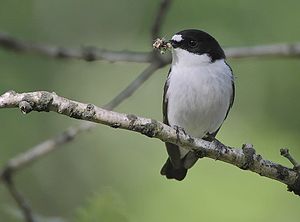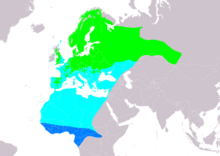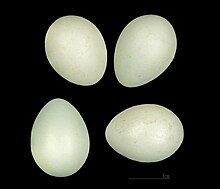Pied flycatcher
| Pied flycatcher | ||||||||||||
|---|---|---|---|---|---|---|---|---|---|---|---|---|

Pied flycatcher ( Ficedula hypoleuca ) |
||||||||||||
| Systematics | ||||||||||||
|
||||||||||||
| Scientific name | ||||||||||||
| Ficedula hypoleuca | ||||||||||||
| ( Pallas , 1764) |
The pied flycatcher ( Ficedula hypoleuca ) is a songbird from the family of flycatchers (Muscicapidae).
description
Pied flycatcher females look very similar to those of the collar flycatcher. The upper side of the male is pitch black, but also dark brown in some areas. The top of the female is light brown. The underside is colored white. The rather round bird also has a short, wide beak and white patches of wings. The male has a white spot on the forehead that is absent in the female. The pied flycatcher is a maximum of 13 centimeters long, can weigh up to 15 grams and reaches an age of 9 years.
habitat
In northern and central Europe , the long-distance migrant is widespread in deciduous and mixed forests, parks and gardens from April to September. It is most common where there are enough tree hollows and nest boxes for breeding; In some areas he is completely dependent on the latter. He has his winter quarters in tropical Africa . Due to climate change , the pied flycatcher tends to return to Europe earlier and earlier in spring; this leads to conflicts with year-round birds such as the great tit , which is increasingly causing distress to pied flycatchers because of the competition for food and nesting sites.
nutrition
The pied flycatcher sits on various branches and posts, carefully observes its surroundings and prey on insects in a precise flight . In autumn it also feeds on fruits and berries .
As with all flycatchers, these are waiting hunters who snatch insects from the air. The pied flycatcher also reads insects from walls and bark while shaking . The prey is hit against a surface until the legs and antennae break off. The remaining hard parts are eaten with and later spat out as vaults .
Reproduction
As a cave-breeder , the pied flycatcher builds its nest in tree hollows and nesting boxes out of grass, stalks, twigs, roots and bark and upholstery it with feathers or hair. In the breeding season from May to July, the female lays 5 to 8 light blue eggs. The eggs are kept warm for 12 to 13 days until the young birds can hatch. After 14 to 16 days, the young fledged and familiarize themselves with the environment.
Finnish researchers reported in 2012 that the clutches of pied flycatchers contain more eggs and at the same time have more mass, the larger the clutches of other bird species that breed in their vicinity.
Existence and endangerment
The breeding population in Germany is estimated to be between 70,000 and 135,000 breeding pairs between 2005 and 2009. In the Red List of Germany's breeding birds from 2015, the species is listed in Category 3 as endangered.
See also
Handicap principle : About the connection between shell color and immune defense of the nestlings
literature
- Urs N. Glutz von Blotzheim (Hrsg.): Handbook of the birds of Central Europe . Edited u. a. by Urs N. Glutz von Blotzheim and Kurt M. Bauer. Volume 13/1, Passeriformes (4th part), Muscicapidae - Paridae . Aula, Wiesbaden 1993. ISBN 3-89104-022-9 , pp. 165-263.
- Stein A. Sæther et al .: Sex Chromosome-Linked Species Recognition and Evolution of Reproductive Isolation in Flycatchers. In: Science. 318, No. 5847, 2007, doi: 10.1126 / science.1141506 .
Web links
- Singing pied flycatcher at www.vogelstimmen-wehr.de
- Ficedula hypoleuca in the endangered Red List species the IUCN 2008. Posted by: BirdLife International, 2008. Accessed January 31 of 2009.
- Videos, photos and sound recordings of Ficedula hypoleuca in the Internet Bird Collection
- Age and gender characteristics (PDF; 5.7 MB) by Javier Blasco-Zumeta and Gerd-Michael Heinze (English)
- Feathers of the pied flycatcher
Individual evidence
- ↑ JM Samplonius and C. Both (2019). Climate Change May Affect Fatal Competition between Two Bird Species. Curr. Biol. 29.
- ↑ Jukka T. Forsman et al .: Observed heterospecific clutch size can affect offspring investment decisions. In: Biology Letters. 8, No. 3, 2012, doi: 10.1098 / rsbl.2011.0970 .
- ↑ Christoph Grüneberg, Hans-Günther Bauer, Heiko Haupt, Ommo Hüppop, Torsten Ryslavy, Peter Südbeck: Red List of Germany's Breeding Birds , 5 version . In: German Council for Bird Protection (Hrsg.): Reports on bird protection . tape 52 , November 30, 2015.


